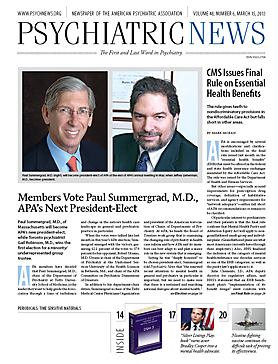The past decade may be dubbed the decade of technology. With social media, smartphones, cloud computing, and other technological advances that are occurring at a dizzying pace, what would have been considered science fiction just a couple of decades ago, has become an everyday phenomenon. Technology is playing an increasing role in our lives and medical practices. From health information technology, including electronic health records, to telemedicine, we are learning to practice in the digital age. New technologies bring both opportunities and risks to health care professionals.
There is often a sense that modern technology would have little use for most patients with mental illness. For example, it is thought that many of our patients would not be able to use video-exercise games or smartphones. New research challenges these notions. Done properly, not only can people with psychiatric disorders use these technologies, but they can also benefit from their therapeutic uses.
I asked two of my younger colleagues to provide an overview of how technology, especially mobile technology, is changing psychiatry. Below is a brief summary of the state of this area, presented by Ipsit Vahia, M.D., and Colin Depp, Ph.D.
Ipsit Vahia, M.D., and Colin Depp, Ph.D. Vahia
The past decade will likely be remembered for the dramatic advances in communication technology and how these have fundamentally altered the way people interact with each other. Psychiatry has only recently begun to realize the potential of technology and how it provides us with unprecedented tools to better understand and treat serious mental illnesses (SMI). We will describe a few of the ways technology has impacted psychiatry.
Access to Care and Ongoing Engagement in Treatment: With the proliferation of hardware such as teleconferencing systems and software such as Skype that facilitate face-to-face engagement with physicians, patients can have access to clinicians and interventions on an ongoing basis. Resources such as neuropsychological testing and access to health support staff in between office visits make care more accessible and reduce dropout rates. We are beginning to gain a more sophisticated understanding of how and where such technology can be most impactful and cost-effective. Over time, remote communication with patients will likely become more integral to psychiatric care, especially as the disparity between demand and availability of care grows.
Collecting Data: A limitation of traditional retrospective approaches to collecting behavioral data has been that recall bias or social desirability (for example, reporting higher degrees of medication adherence or lower rates of substance use) may affect the quality of information obtained. Mobile technology can now be used to gather data on health behaviors and symptoms in real time and outside of the clinic setting, using text messages (for example, “are you currently feeling sad?” or “on a scale of 1-10, how stressed do you feel right now?”) Such methods have shed light on the daily experiences of people with SMI.
A Platform for Novel Technology-Based Interventions: Based on daily assessments of symptoms and related experiences, several mobile interventions have been designed to deliver real-time and highly personalized interventions. One example of this is the recently published Mobile Assessment and Treatment of Schizophrenia (MATS). MATS uses text-messages for a variety of purposes—to ask questions related to current health and symptoms (e.g., “are you experiencing voices at this moment?”), to challenge thoughts (e.g., “maybe the voices do not have all the answers?”), and to make suggestions for coping (e.g., “perhaps you can talk to a friend”). Researchers found adherence to MATS to be over 80 percent. For many patients, participation in MATS improved medication adherence, socialization, and auditory hallucinations. Other interventions, such as Personalized Real Time Intervention for Stabilizing Mood (PRISM), have targeted outcomes in bipolar disorder, and early findings have supported their use.
Commercial Technology: Some research has assessed use of commercially available devices for psychiatric care. We evaluated whether exergaming with a popular gaming system (Nintendo Wii) could impact subsyndromal depression in older adults. The study found that depression scores were significantly reduced among older adults who played a physically active video game for 30 minutes three times a week for 12 weeks. Ongoing studies are also examining whether visuospatial stimulation and/or distraction techniques such as photo or video apps may help in controlling sundowning among persons with dementia. While technology-based interventions have been used primarily in young adults with SMI, devices are increasingly designed to be simpler and more intuitive to use, and older adults may be able to benefit greatly from these.
Limitations and Questions: Despite the excitement in the technology arena, questions remain regarding its use in mental health care. The number of high-quality randomized, controlled trials is small. It is unclear if the potential cost savings in delivery will offset initial costs for buying equipment and training. There are also potential bioethical concerns related to issues such as compromised privacy, data security, loss of devices, and technical issues. Moreover, long-term adherence to technology-based interventions has yet to be established. The impact of mobile technology on therapeutic alliance with clinicians has also not been assessed.
In addition, an important question is whether long-term use of devices may exacerbate psychiatric conditions. There has been speculation that audiovisual hyperstimulation from use of such devices at an early age may predispose children to ADHD or anxiety. Given how ubiquitous communication technology is, psychiatrists will likely find themselves considering these issues in formulations of mental illness, especially among adolescents and young adults.
In summary, as communication technology becomes ever more important, strategies for leveraging this technology for clinical care of SMI are rapidly emerging. Rigorous research is needed to establish benefits, risks, and cost-effectiveness of technology in psychiatric practice. To conclude on a different note, an immediate benefit of mobile technology will hearten those of us exhausted by years of lugging around heavy abstract and program books at the APA annual meeting—there is an app for that. ■


